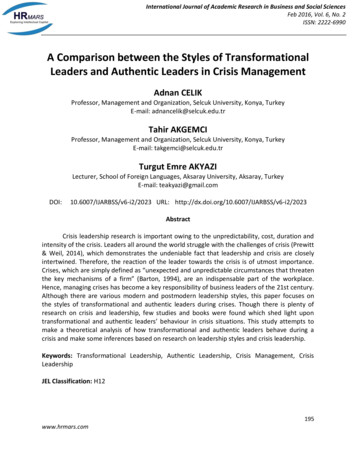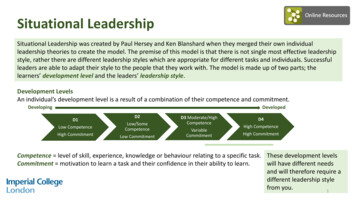
Transcription
Leadership StylesWorkbook
The Leadership Styles Workbook MindTools.comThe Leadership Styles WorkbookThis e-book is published by Mind Tools Limited, of2nd Floor, 145-157 St John St, London, EC1V 4PY.Version 1.2Copyright Mind Tools Ltd, 2009-2011. All rights reserved.This e-book is protected by international copyright law.You may only use it if you have downloaded it directlyfrom the mindtools.com site, or if you have received itunder license from Mind Tools Ltd.Cover image iStockphoto/Mlenny Mind Tools Ltd, 2009-2011.2
The Leadership Styles Workbook MindTools.comContentsIntroduction . 4Understanding Leadership Styles . 5Laissez-faire Leadership . 5Transactional Leadership. 5Transformational Leadership . 6Test Your Knowledge! . 9Example One: “George” . 9Example Two: “Ann” . 9Example Three: “Chris” . 10Our Answers . 11Self-Awareness Exercise .11Key Learning Points .12Have you found this e-book useful? .13 Mind Tools Ltd, 2009-2011.3
The Leadership Styles Workbook MindTools.comThe Leadership Styles WorkbookIntroduced by Mind Tools CEO, James ManktelowThere are manydifferent ways inwhich you can lead,some good, somebad.In this workbook,we’ll study three ofthe most commonstyles you’re likelyto encounter in theworkplace,andwe’ll look at theirstrengths and weaknesses. These are: Laissez-faire leadership. Transactional leadership. Transformational leadership.It’s a good idea to learn as much about thesestyles as possible for two important reasons:Firstly, the key to working successfully with amanager, supervisor or any other kind of bossis to understand their particular style and adaptto it. This isn’t always easy, but it’s essential fora successful career! Secondly, if you’re going tosucceed as a leader, you need to adopt anduse the leadership style that best fits yourpersonality and the circumstances of your job. Mind Tools Ltd, 2009-2011.If you get this wrong, you risk spectacularfailure. However, if you get this right you’ll getmany benefits: Less stress.Increased income potential.Increased promotion opportunities.Greater job satisfaction.This workbook helps you understand thesethree leadership styles, and then think abouthow this applies to you. By the end of it, you’llunderstand the strengths and weaknesses ofyour own preferred approach; you’ll be able toreflect on whether this approach is appropriateto the situation you find yourself in; and you’llthink about changes you may need to make tolead in the best way possible.James Manktelow, CEO,MindTools.com4
The Leadership Styles Workbook MindTools.comUnderstanding Leadership StylesBefore you get started on studying leadershipstyles, it’s important to recognize that people donot always stick to one style rigidly.That is, many leaders use a mixture of styles.Seldom will you run into a manager, supervisoror other leader who’s exclusively a laissez-faire,transactional or transformational leader. In fact,wise leaders adapt their styles to thecircumstances, the organization, and theemployees.The information provided below will help yourecognize the preferred leadership style ofleaders with whom you work.Laissez-faire LeadershipThe term “laissez-faire” is a French phrasemeaning “leave it be.”It’s used to describe a leader who leaves his orher colleagues mostly alone to get on with theirwork. It’s an effective style when a team isgenerally made up of the individuals who arevery experienced and skilled self-starters, andwhere the leader monitors what’s beingachievedandcommunicatesthoseachievements (or lack of them) back to theteam on a regular basis.At the other end of the spectrum, this approachcan be disastrous in situations in whichinexperienced team members need cleardirection. Here’s a real-life example involving alaissez-faire leader we’ll call “Jim”:Jim was the manager of a corporate unitwith mostly new and inexperienced teammembers. He’d risen to the position on thestrength of his personality and the ability tocharm clients. Put bluntly, he “wowed” thecompany’s customers.Unfortunately, he didn’t wow his team.Although he possessed an impressivedegree and considerable knowledge, as aleader he was vague about goals, indecisiveabout objectives, and had developed Mind Tools Ltd, 2009-2011.procrastination to a fine and excruciatingart. He put everything off to the lastmoment. Worse, Jim tended to disappearwhen his decisions were needed the most!The result was that, much of the time, themembers of his team didn’t know what wasgoing on. They were looking for leadershipand found none.You can guess the eventual outcome of thispoor form of laissez-faire leadership:Deadlines were missed, and productdelivered late. Clients grew unhappy and letJim’s company know about it.Jim was replaced with Deborah, a leaderwho knew how to work with inexperiencedteam members. She provided specificgoals, communicated those goals clearly,and made her knowledge and experiencereadily available to all team members.Within short order, she’d turned thingsaround and made everyone happy – clients,team members, and the company.Although laissez-faire leadership does have itsplace, it’s rarely as effective as the transactionaland transformational styles described below.Transactional LeadershipThis style of leadership is based on a simplepremise: that people are motivated by rewardand punishment. It also assumes that systemswork best with a clear chain of command.In essence, transactional leadership says thatwhen you, as a team member, agree to do ajob, you cede all authority to the leader. This ispart of the “transaction.” Your purpose is to dowhat that leader tells you to do. If you succeed,you’ll receive a pre-determined reward. If youfail, the organization has the right to “punish”you if the work doesn’t meet a pre-determinedstandard. This type of leadership boils down to: Reward: “Do as I tell you, and you’ll get abonus, raise or promotion.”5
The Leadership Styles Workbook MindTools.com Punishment: “If you don’t do this, youwon’t get any more than your basic pay,and might even get fired.”Although this is a common style, it’s not really aform of leadership: it’s more a style ofmanagement, because it focuses on short-termtasks rather than a larger vision or goal.As you might expect, team members can dolittle to improve their job satisfaction undertransactional leadership. In turn, this ischallenging for leaders who want to motivatetheir teams. The only real method open to themis to give team members some control of theirincome/reward by using incentives thatencourage even higher standards or greaterproductivity. Transactional leadership is not agood fit for knowledge-based or creative work,because of its focus on short-term tasks.What’s more, it’s a cold and somewhat-soullessway of managing. In parts of the world wheregood employees are hard to come by anddifficult to retain, it fails to meet people’s needsfor job satisfaction, and therefore makes it moredifficult to attract and retain good staff.Transformational ional leadership” style is a trueleader.He or she inspires a team with a shared visionof the future. Transformational leaders arehighly visible, and spend a lot of timecommunicating. They don’t necessarily leadfrom the front, as they tend to delegateresponsibility amongst their team. And whiletheir enthusiasm is often infectious, they canoften need to be supported by “details people”.Component 1: Being a Good Role ModelTransformational leaders know they’re rolemodels for team members. At a gut level, theyrealize that those members will behave in thesame way that the leader does. To that end,transformational leaders have a clear set ofadmirable values and live those values ineverything they do. This builds trust betweenthemselves and team members.Note that we mentioned “admirable” values.The Enron scandal in America is an example ofleaders demonstrating horrifically bad values,displaying greed, deception, lying, andmanipulation. They were “anti-transformationalleaders” and role models in the worst possibleway! Everyone paid a heavy price for theirbehavior.Component 2: InspirationPut plainly, transformational leaders know howto motivate people in a powerful fashion. Theydo this in three main ways:1. They have high standards, andchallenge team members to meet orexceed those standards. This providesa strong and uniting sense of purpose.2. Such leaders are unfailingly, butrealistically, optimistic. To their core,they know goals can be met andobstacles can be overcome.3. Transformationalleaderscommunicate clearly on every level.They have the ability to paint acompelling picture of the future in sucha way that team members know exactlywhat the goals are, and what their rolesare in achieving those al leaders? Well, according towell-respected researchers (Burns, Bass &Avolio, for example), there are four primarycomponents1:Component 3: Commitment to ideas andcreativityTransformational leaders know that they hireteam members for their brains, not their abilityto perform rote tasks. They want creativity fromtheir teams, so they actively seek it and1emphasis. However, these are usually just differentways of looking at the same leadership erentdepending on perspective and Mind Tools Ltd, 2009-2011.6
The Leadership Styles Workbook MindTools.compromote it. Of course, these leaders harnessteam creativity to the overall goal so that goalgets accomplished in the most effective andefficient way possible. In short, transformationalleaders have a “big picture” view and doeverything within their power to connect teammembers, the organization and themselves tothat view.Component 4: Concern for individual teammembersTransformational leaders have the ability totruly listen to the needs and concerns ofindividual members of the team.But it doesn’t stop there: these leaders knowthat team members are the future of the teamand of the organization; therefore, it simplymakes sense to help them grow as fulfilledindividuals. Transformational leaders mentorteam members to help them gain knowledgeand experience. In short, they are leaders whohelp team members become future leaders.Truth be told, both transactional andtransformational leadership are needed in manyorganizations. That’s because these styles candovetail together very nicely. Transformationalleaders look after long-range initiatives that addvalue, while the transactional leaders (ormanagers) ensure that routine work is donereliably.Note:In fact, the best leaders combine bothapproaches: Leading in an inspiring,transformational way, while managingdelivery effectively and reliably. These aredifferent skill-sets, however they can beembodied within one person.The very name “transformational” tells it all:This style allows you to transform theworkplace, your team members, and the Mind Tools Ltd, 2009-2011.company itself through the introduction of newideas and by helping team members grow asindividuals. That, in turn, can lead to newsolutions, increased efficiency, and happy teammembers. In short, a transformationalenvironment can be an exciting and stimulatingplace to work. Who could ask for more?!Tip:You don’t have to be a leader in name to bea leader! Within many organizations, you’llfind informal leaders in particular areas. Forexample, Amy may be an outstanding writerwhen it comes to putting together a salesproposal. Or Ben may be a whiz when itcomes to crunching numbers for a bid. Boththese individuals are “informal” leaders.They’re the “go to” people in their respectiveareas. The point: you still need to be agood leader even when you’re an informalone!Action: Now that you understand the threeprimary forms of leadership, it’s time to applythe information you just learned to leadersyou’ve encountered during the course of yourlife. They can be leaders you actually workedunder, or they can be leaders you observedheading up different teams. Select one whomyou considered successful and one whom youdeemed ineffective. Then, answer the questionson the next page with regard to each of theseindividuals.Note:There are other leadership styles found lessoften in the workplace than the three wefocus on here. For more on these, read ourarticle “Leadership styles, using the right onefor your situation” at:http://www.mindtools.com/pages/article/newLDR 84.htm.7
The Leadership Styles Workbook MindTools.comThe Successful LeaderLeader’s name:What made this leader effective? What made this person so successful?Which leadership category would best describe this person’s style? (check one)Laissez-FaireTransformationalTransactionalThe Ineffective LeaderLeader’s name:Why was this leader ineffective? What led this person to be unsuccessful?Which leadership category would best describe this person’s style? (check one)Laissez-FaireTransformationalWhile it won't necessarily be the case that thesuccessful leader used a transformational styleand the ineffective one was largely laissez-faireor transactional, in most cases this WILL be thecase. If this isn't so, what were the very specific Mind Tools Ltd, 2009-2011.Transactionalcircumstances that made the successful leadereffective despite not having a transformationalstyle, or the unsuccessful leader ineffectivedespite having a transformational style? Writethese down below.8
The Leadership Styles Workbook MindTools.comTest Your Knowledge!Action: One of the best ways to confirm yourknowledge of leadership styles is to apply thisknowledge immediately! So, below we’veprovided three examples of leadership for youto analyze. Read these examples, answer thequestions that follow, and then check out theanswers on page 11.Example One: “George”George is the manager of a corporate unitwith a lot of new and inexperiencedemployees. He’s a very nice man whom youand all your co-workers like. He giveseveryone lots of responsibility and expectsthem to carry out tasks without bothering him.He can be hard to find when you need adecision and, in fact, tends to put his owndecisions off until the last moment.Example Two: “Ann”Ann is also the manager of a corporate unit.She’s available in her office at any time and,in fact, makes it a point to visit with you andyour co-workers to find out what you’rethinking in regard to assigned projects. Whena decision needs to be made, she makes itquickly. She’s tough and demanding but fairand enthusiastic and expects her team to bethe same. She sets high goals, but gives youevery tool you need to achieve those goals.What style of leadership does Ann display?What’s the likely impact of Ann’s style on youand your co-workers?What leadership style does George display?What’s the likely impact of George’s style onyou and your co-workers?What’s the likely impact of Ann’s style oncompany productivity?What’s the likely impact of George’s style oncompany productivity? Mind Tools Ltd, 2009-2011.9
The Leadership Styles Workbook MindTools.comExample Three: “Chris”Like George and Ann, Chris is the manager of acorporate unit. He’s committed to carrying out thegoals of the company in the most efficient waypossible. He’s a “hands-on” type of person andmakes it clear that good performance will bringteam members rewards while poor performancewill send a below-par team member out the doorin short order. Chris has established a very clearchain of command so team members alwaysknow exactly what they’re supposed to do.What style of leadership does Chris display? Mind Tools Ltd, 2009-2011.What’s the likely impact of Chris’ style on youand your co-workers?What’s the likely impact of Chris’ style oncompany productivity?10
The Leadership Styles Workbook MindTools.comOur AnswersExample One: “George”George exhibits a loose, “laissez-faire” style ofleadership and a fairly bad one at that, giventhe situation. He’s afraid to make decisions andto take responsibility. So, he lets you and yourco-workers make the decisions. Remember,most of the team members are new andexperienced, so the likely impact of his style isthat no one is exactly sure what is going on inregard to projects and everyone ends up pullingin different directions. The result is frustration,delays, and unhappiness at all levels.Example Two: “Ann”Ann has a transformational style of leadership.She sets clear standards and expects her teamto meet them. She also expects ideas fromeveryone under her leadership and activelyintegrates them into projects. Ann isenthusiastic and transmits that enthusiasm toher team. The likely result is high morale, activeparticipation, and superior results.Example Three: “Chris”George is a transactional style of leader. He’scommitted to carrying out the goals of thecompany in the most efficient way possible.He’s a “hands-on” type of person and makes itclear that good performance will bring rewardsto team members while poor performance getspunished. The likely impact of his style is thatproductivity will always remain good, which hiscompany will definitely appreciate. However,Chris’ style may stifle creative members of histeam, and this can lead to an exodus of muchneeded future talent.Self-Awareness ExerciseBy this point, you understand the three mostcommon leadership styles, and you’ve hadpractice in evaluating those styles. Now, it’stime for a little honest self-analysis. We saidearlier that it’s important for you to know whatstyle fits you best. So, to the best of your ability,answer the questions below in regard to thissubject.Of the three styles (laissez-faire, transactional,and transformational), what style do you feelmost comfortable with and why? Mind Tools Ltd, 2009-2011.What would you like to change or improveabout your current leadership style?In terms of the people you’re now leading, whatdifficulties have they had (if any) with yourleadership style? If they’ve had difficulties, howdo you propose to improve the situation?11
The Leadership Styles Workbook MindTools.comWe asked you the above questions for two veryimportant reasons. The first reason is that it’svital for you to understand your natural style.This gives you a baseline from which tooperate. You may be a person who’s highlycreative and craves a loose, energeticenvironment where you can have a lot of input.This tells you that an autocratic or bureaucraticenvironment is definitely not your cup of tea!Or you may be an individual who’s highlyanalytical and needs a definite structure so youcan be as effective and efficient as possible. Ifthat’s the case, then it’s likely that you’d beuncomfortable in a laissez-faire organization. Inshort, this self-awareness can help you find thebest fit for both you and a potential employer.Self-awareness serves a second purpose aswell. It helps you adapt to situations where theleadership style isn’t a natural one for you. Weall change jobs. We all change companies.Often, bosses change! In any of these cases,we have to adapt. With the knowledge providedin this session, you can be as flexible andeffective as possible in any new leadershipsituation.We mentioned earlier that we feel that thetransformational leadership style is one of thebest for today’s competitive market. That’s whyit’s the dominant leadership style taught in theMind Tools How to Lead: Discover the LeaderWithin You leadership program, which is one ofthe free joining bonuses for members of thecareer-boosting Mind Tools Club.However, keep in mind that other leadershipstyles are appropriate as the situationdemands! In other words, there’s no “one sizefits all” leadership solution. You have to analyzeeach situation and determine the best fit. To dothis, you must consider: The skill levels and experience of yourteam. The work involved (routine or new andcreative). The organizational environment (stable orradically changing, conservative oradventurous). Your own preferred or natural style.Good leaders find themselves switchinginstinctively between styles according to thepeople and the work they’re dealing with.Key Learning PointsThe first key point is that there are manydifferent leadership styles. Some of the mostcommon ones are: Laissez-faire leadership. Transactional leadership. Transformational leadership.Of these, the transformational leadership styleis often the most effective. Core elements ofthis are being a great role model, inspiring yourteam to perform excellently, being committed tousing and integrating people’s ideas, andhaving a concern for team members’ wellbeing. Mind Tools Ltd, 2009-2011.The second key point is that in order to becomea leader, and work successfully with leaders,you must understand all the advantages anddisadvantages of these styles and be able toadapt to them as the situation demands.A third key point is that you must do somehonest self-analysis to identify your naturalstyle, so that you can situations in which you’llthrive during the course of your career.The final key point is to recognize the fact thatwhile transformational leadership is usually thebest choice, it’s by no means the only choice. Awise leader reads the situation and adopts theleadership style that works best.12
The Leadership Styles Workbook MindTools.comHave you found this e-book useful?If so, here are a few ideas for your next steps 1) Visit MindTools.com to learn more than 100 career skills for free. Our Home, Tool Finder and MostPopular pages are great places to start.2) Subscribe to our free weekly email newsletter, and get new career development tools deliveredstraight to your inbox. (Plus, you’ll get a copy of our Personal Development Planner as a welcome gift.)3) Ready to take a step up in your pursuit of a better life and career? The Mind Tools Club is ourexclusive members-only area. Inside you'll find more than 1,000 tools and resources designed to helpimprove your skills, faster. Everything is written in easy-to-understand language – perfect for peoplewith busy lives. Explore more than 600 personal excellence tools – offering easy-to-follow advice. Choose from audio downloads, assessment tests, one-hour summaries, articles and more. Go at your own pace, in your own time – learning the way you want to learn. Connect with other passionate and driven professionals in our thriving community forum. Get “on-tap” advice and support from experienced career mentors and coaches.Explore the Club for just US 1 for your first month.(After that, it's US 19 or US 27 per month, with our cancel at any time, money-back guarantee.)Join today and, as a thank you, we'll give you four bonus career-enhancing courses worth US 121for free.Are you responsible for training for your team or your organization?Mind Tools online training is accessible, saves money, and helps you build confident, capable andeffective managers. With it, you can: Set up corporate access to our rich blended learning environment, the Mind Tools Club.Populate your intranet or learning management system with Mind Tools resources.License our material to support specific training interventions.To find out more (or to explore other options) contact our organization development team on 1 617 418 1731 (US) or 44 20 8144 5768 (UK), email corporate.enquiries@mindtools.com, or visithttp://www.mindtools.com/corp/index6.php.I hope you enjoy exploring our training material – and I look forward to hearing about your progress!James Manktelow, CEO, MindTools.com Mind Tools Ltd, 2009-2011.13
Transformational Leadership . By contrast, a person using the “transformational leadership” style is a true leader. He or she inspires a team with a shared vision of the future. Transformational leaders are highly visible, and spend










